You might think that if a species died out tens of millions of years ago, its design would be too primitive to have any applications in modern-day technology. A new analysis of pterosaur bones, however, suggests that their microstructure could inspire lighter, stronger aircraft materials.
Pterosaurs were flying reptiles that lived throughout the world 228 to 66 million years ago.
Some types had a wingspan of up to 11 m (36 ft), making them the largest flying animals of all time. Needless to say, keeping body weight down was essential in order for such sizable reptiles to take flight.
Pterosaurs thus had hollow, lightweight wing bones similar to those of birds. Those bones also needed to be strong, though, to support the load of the tough, leathery wing membranes. That brings us to the new study.
Led by PhD student Nathan Pili, scientists at The University of Manchester recently utilized X-ray computed tomography to 3D-scan fossilized pterosaur wing bones at near sub-micrometer resolution.
It was found that the "solid" sections of the hollow bones were actually permeated with tiny canals, each one of which was about one-twentieth the width of a human hair. These structures likely served to transfer nutrients throughout the bone tissue, and to facilitate bone growth.
That said, it was determined that they also kept cracks from permeating into the bone. If a micro-fracture were to form on the surface of the bone, it would only go down as far as the first canal, which would stop it. The tiny surface crack that did exist would subsequently heal relatively quickly.

Modeling showed that if such an internal microstructure were to be used in aerospace materials (such as 3D-printed metal), it could allow for next-generation aircraft components that combine light weight with high strength.
"Of all the species that have ever lived, most are extinct, though many died out due to rapid environmental changes rather than 'poor design,'" says Pili. "These findings are pushing our team to generate even higher-resolution scans of additional extinct species. Who knows what hidden solutions we might find."
Source: The University of Manchester




